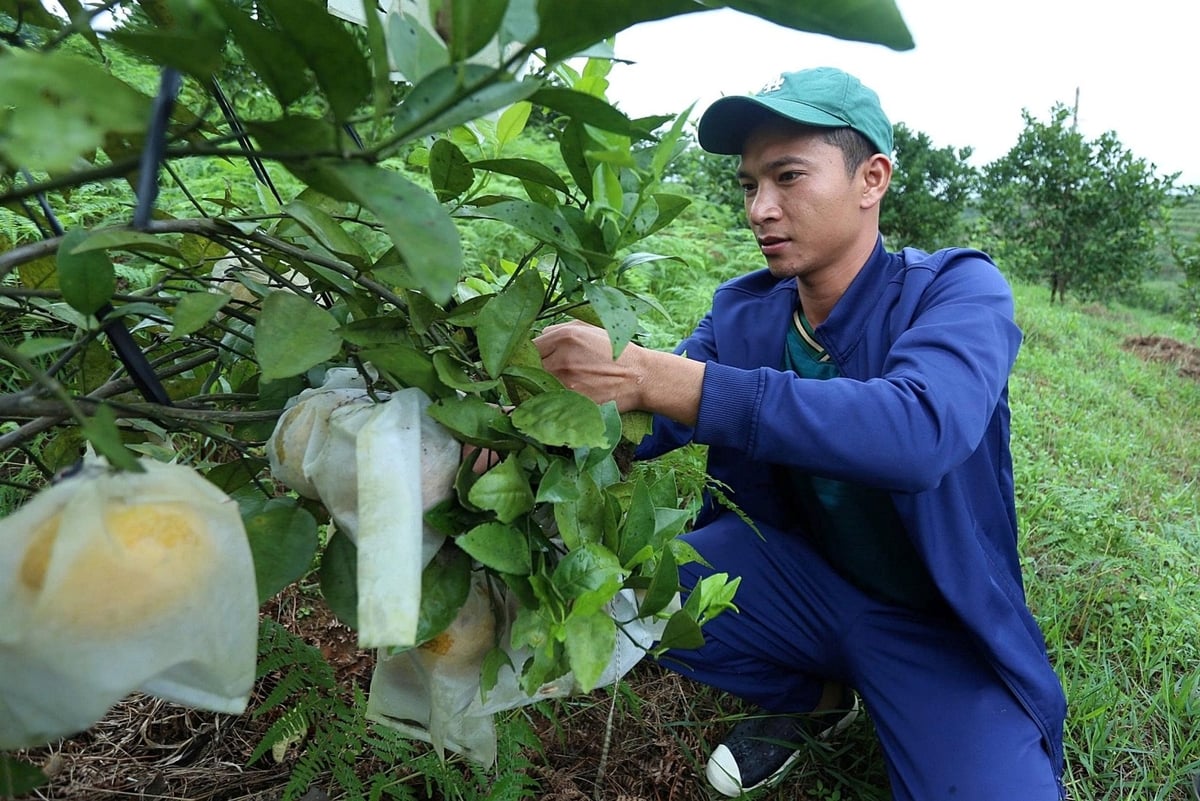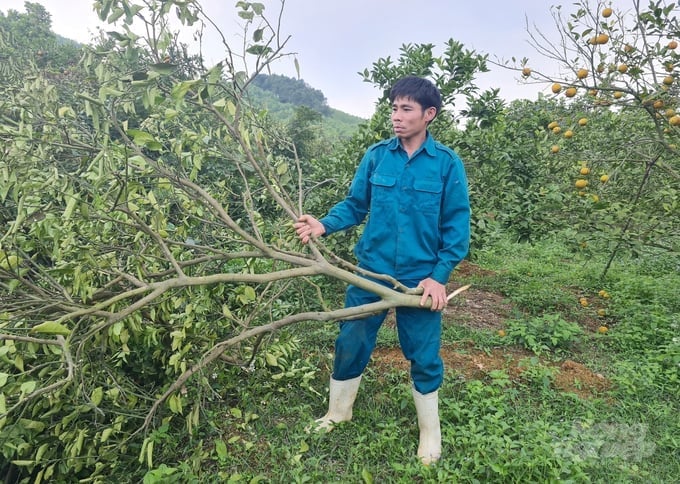November 21, 2025 | 11:13 GMT +7
November 21, 2025 | 11:13 GMT +7
Hotline: 0913.378.918
November 21, 2025 | 11:13 GMT +7
Hotline: 0913.378.918
The North Central region was once considered the citrus capital of northern Vietnam, home to renowned names deeply embedded in consumers’ minds, such as Vinh oranges (Nghe An), Phuc Trach pomelos (Ha Tinh), Luan Van red pomelos (Thanh Hoa), and Thanh Tra pomelos (Hue).
However, after a period of rapid expansion from 2010 to 2020, citrus-growing areas in the North Central region are now facing a silent crisis. Acreage, yields, and fruit quality have all declined simultaneously. What was once seen as a pathway to prosperity has turned into hardship for many farmers, as they now struggle with widespread pest infestations, massive tree die-offs, and unstable markets.

Dr. Nguyen Thi Bich Ngoc shared her insights at the North Central Provinces’ Agricultural Production and Consumption Connection Forum, held on the morning of August 6 in Nghe An. The event was organized by the Vietnam Agriculture and Nature Newspaper in collaboration with the Vietnam Gardening Association, the National Agro-Forestry-Fisheries Quality Assurance Department, the Plant Production and Protection Department, and the Nghe An Department of Agriculture and Environment. Photo: Ba Thang.
According to the Ministry of Agriculture and Environment, by 2024, the total citrus-growing area in the North Central provinces will have reached approximately 27,900 hectares, accounting for over 11.5% of the country’s total. Of this, pomelo covers 11,600 hectares with an output of 122,600 tons, while orange cultivation occupies a similar area, yielding around 126,000 tons.
Despite being considered specialty crops with high economic value, once earning farmers hundreds of millions of dong per harvest, the current state of citrus production is alarming.
In Nghe An, the orange-growing area once reached nearly 5,500 hectares but had shrunk to just around 2,500 hectares by early 2023. In Hue City, more than 600 hectares of Thanh Tra pomelo have been completely wiped out. Many orange and pomelo orchards, even with trees over six years old already bearing fruit, now suffer from premature fruit drop, poor quality, or no harvest at all due to stunted growth, yellowing leaves, and root rot. A number of orchards have been abandoned, leaving growers discouraged and disheartened.
The Plant Protection Institute has identified several key causes: poor-quality varieties that are prone to early infection, soil degradation due to improper farming techniques and overuse of chemical fertilizers, and the widespread outbreak of diseases such as citrus greening (Huanglongbing), gummosis, nematodes, and mealybugs - none of which currently have effective treatment solutions.

By 2024, the total citrus-growing area in the North Central region had reached approximately 27,900 hectares. Photo: Ba Thang.
Notably, the Asian citrus psyllid - the vector for citrus greening disease (HLB/Greening) - has become increasingly prevalent under the abnormal weather conditions caused by climate change.
Another factor contributing to the decline of citrus-growing areas in the North Central region is the fragmented and small-scale nature of production. Many orange and pomelo growers operate independently, without being part of cooperatives or value chain linkages. Growing areas have not been systematically planned or certified according to VietGAP, GlobalGAP, or organic standards.
At the same time, unstable market conditions have led to volatile prices and an unsustainable sales outlook. Farmers are reluctant to invest in orchard rehabilitation for fear of losses, creating a vicious cycle of stagnation.
Experiences from major citrus-producing countries such as the United States, Taiwan, Thailand, Australia, and Spain show that sustainable recovery of citrus crops must begin with disease-free planting material and implementing integrated pest management (IPM).
In Taiwan, new cultivation techniques are designed as a comprehensive system, from digging planting holes and improving soil quality to drainage systems and selecting disease-resistant rootstocks. Citrus seedlings must be certified as disease-free before being planted in the field, and psyllid populations (the vector) are controlled using systemic insecticides applied at the appropriate time.

Widespread pest outbreaks have devastated many citrus-growing households in the North Central region, forcing them to uproot their orchards. Photo: Ba Thang.
Some countries have adopted rapid diagnostic kits to quickly detect pathogens and remove infected trees at an early stage. Infected trees may be treated with antibiotics or managed using zinc, copper, and silica nanoparticles to suppress bacterial growth. At the same time, tree and soil health are enhanced by applying organic matter, microbial fertilizers, and balanced macro- and micronutrients.
Dr. Nguyen Thi Bich Ngoc, Deputy Director of the Plant Protection Research Institute, emphasized that restoring and developing citrus production in the North Central region requires a comprehensive set of solutions.
In terms of varieties, localities need to invest in establishing disease-free propagation centers and apply shoot-tip micrografting techniques to rehabilitate local specialty varieties. New plantings should use healthy seedlings with strong disease resistance and the ability to produce uniform, high-quality fruit.
A transition to organic and circular farming models is essential for cultivation and soil management. This includes utilizing agricultural by-products as fertilizers, conducting soil tests before planting, and adopting raised-bed planting techniques to promote healthy root systems. Proper pruning and stage-specific fertilization also help boost yields and reduce pest infestations.
For pest and disease control, a strict application of Integrated Pest Management (IPM) is recommended, from using disease-free planting material and controlling psyllids with biological traps and approved pesticides, to applying microbial products capable of producing natural antibiotics. Rapid on-site disease diagnosis is also crucial to ensure timely and effective treatment.

Disease-free planting material is one of the top requirements for the sustainable development of citrus crops in the North Central region. Photo: Ba Thang.
Regarding production organization and market development, it is essential to rezone citrus-growing areas to match local soil and climate conditions, support farmers in transitioning to VietGAP or organic-certified cultivation, and strengthen linkages with enterprises involved in purchasing and processing to ensure stable market access. At the same time, efforts should be made to enhance traceability, establish planting area codes, and apply digital transformation tools for pest warning systems and more effective technical management.
According to the Plant Protection Research Institute, several complete technical packages have already been developed, including: a shoot-tip micrografting protocol for producing disease-free mother trees; a microbial-based recovery process for orchards affected by citrus greening; a no-tillage seedling production method; a rapid diagnostic kit for detecting citrus greening disease; and procedures for orchard replanting and crop conversion.
The Institute is also providing technical support to several cooperatives working to export Vietnamese pomelos to the UK and the US. “We are ready to collaborate and transfer advanced technologies to localities in need, to help restore citrus production areas,” Dr. Ngoc affirmed.
With its existing potential, the North Central region can fully transform into a hub for high-quality citrus production - provided that production is reorganized in a systematic and coordinated manner, from varieties and cultivation techniques to market access and pest management.
Beyond helping farmers achieve sustainable income, restoring citrus orchards also lays the foundation for developing ecological agriculture and enhancing climate change resilience. These are not only critical challenges for the North Central region but also strategic priorities for Vietnam’s entire agricultural and environmental sector.
Translated by Phuong Linh

(VAN) According to MAE, heavy rains and flooding from November 16-19 caused major losses in lives, homes, and agricultural production across the central provinces.

(VAN) Amid vast floodwaters, the spirit of sharing and helping others shown by many people in Gia Lai reached tens of thousands of residents stranded by raging floods.

(VAN) Climate change is set to emerge as a key focus of collaboration within the framework of the Comprehensive Strategic Partnership between Viet Nam and New Zealand.

(VAN) Future veterinarians will be the ones directly deciding how antibiotics are prescribed, administered, guided and managed across thousands of farms nationwide.

(VAN) Argentine Ambassador Marcos Antonio Bednarski says Viet Nam is playing an increasingly influential role in Argentina’s economic and technical engagement in Southeast Asia, as Buenos Aires is seeking long-term partners.

(VAN) Prime Minister requested local authorities to use all available measures to reach residential areas that are deeply flooded, cut off, isolated, or affected by landslides.

(VAN) To confront historic flood surge on Ba and Kon rivers, the Prime Minister requested local authorities to mobilize all available forces, evacuate residents, and ensure reservoirs and dams safety.